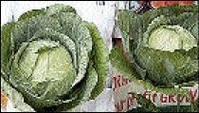Eating organic
Published: Saturday | March 7, 2009

Unusually large cabbage which benefited from organic fertiliser. - JIS Photo
The new buzzword for food, agriculture and the environment is organic. Organics are making their way into supermarkets and natural-food stores.
According to the Mayo Clinic in United States, the word 'organic' refers to the farming and processing methods for agricultural products such as fruit, vegetables, grains, dairy products and meat. Pesticides have been linked to many diseases, including cancer, obesity, Alzheimer's and some birth defects.
Hormone-free
Organic foods are those grown without chemical pesticides or fertilisers. They cannot be fertilised with sewage sludge and cannot be genetically modified. Organic animals have to be fed organic feeds and they cannot be treated with antibiotics nor can they be given growth hormones and they should have access to outdoors. Organic farming practices are designed to encourage soil and water conservation and reduce pollution.
The consumer may want to know the difference between organic foods and conventionally farmed foods and why organic foods are more expensive. The US-based research firm, Environmental Working Group, suggests that for smart shopping, consumers who purchase organic fruits and vegetables reduce their pesticide exposure by as much as 90 per cent.
Organic foods cost more than non-organic foods because it is more expensive to get rid of pests and weeds instead of dumping them with pesticides and herbicides.
In the United States, the Department of Certification Agriculture (USDA) has established strict standards for organic certification of foods. The USDA organic label, which is voluntary for producers, indicates that food is processed according to strict standards and that 95 per cent of the food ingredients are organically produced.
Be careful of foods with product labels that indicate less than 70 per cent organic content. Such products should not be called 'organic' on the label even though organic items may be in the ingredients listing. Labels may carry other terms such as 'all-natural', 'free-range' or 'hormone-free' but they should not be mistaken for 'organic'.
THE ORGANIC FOOD HYPE
More nutritious?
The evidence is inconclusive. Few studies suggest that children who eat organic foods have lower levels of pesticides in their bodies than those who eat foods produced by conventional methods. There is some indication that organic foods have somewhat higher amounts of minerals and vitamins.
Better quality and appearance?
Organic foods meet the same quality and appearance standards as conventional foods:
✓ Free from waxing and preservatives - organic foods will spoil faster.
✓ Less than perfect in appearances indicates that there is no genetic modification.
Better taste?
Little or no difference discerned. It's more of a feel-good factor.
Whether the food is produced conventionally or organically, it should be washed as all produce can be contaminated with harmful bacteria. Washing of fruits and vegetables is standard practice before cooking a meal.
Quasi-Thai Salad
A very refreshing salad with an Asian twist.
1 head organic romaine lettuce, washed and dried
1 cup seeded, peeled and sliced cucumber
1 cup chopped mushrooms
2 cups organic bean sprouts
3/4 cup organic cilantro, coarsely chopped
1/2 cup roasted peanuts or cashews, coarsely chopped
Dressing
3 tbsps peanut butter
2 tbsps canola oil
1 tbsp toasted sesame oil
1 tbsp tamari
1 tbsp honey
2 tbsps fresh, organic lime juice
1/4 tsp cayenne pepper
1/4 tsp red pepper flakes (optional)
Method
1. Blend all the dressing ingredients well.
2. Tear the lettuce to get about 8 cups; you should have about 8 cups. Just before serving, combine the lettuce, vegetables, dressing and half the nuts.
3.
4. Sprinkle remaining nuts over the top and serve immediately. Salad becomes soggy if it sits for too long.
Source:
Heather Little-White, PhD, is a nutrition and lifestyle consultant in the Corporate Area. Send comments to editor@gleanerjm.com or fax 922-6223.
Organic vs conventional farming
There are basic differences between conventional farmers and organic farmers.
Conventional farmers
✓ Apply chemical fertilisers to promote growth.
✓ Spray insecticides to reduce pests and
disease.
✓ Use chemical herbicides to manage weeds.
✓ Use antibiotics, growth hormones and
medication on animals to
Organic farmers
✓ Apply natural fertilisers like manure or compost
to feed soil and plants.
✓ Use beneficial insects and birds, mating
disruption or traps to reduce pests or diseases.
✓ Rotate crops, till, hand-weed or mulch to
control weeds.
✓ Give animals organic feed and allow them to
access outdoors. Disease can be minimised
by rotational grazing, a balanced diet and
clean housing.
